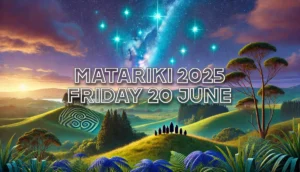Matariki and the Winter Solstice
Celebrating the Change of Season
As the winter solstice approaches in the Southern Hemisphere, many Māori and New Zealanders alike are preparing to celebrate Matariki, a significant event in Māori culture. Matariki, also known as the Pleiades star cluster, is a collection of seven stars that appears in the sky during late May or early June, marking the start of the Māori New Year. It is a time to reflect on the past, acknowledge the present, and plan for the future. In this blog post, we will explore the significance of Matariki and the winter solstice, as well as provide ideas for celebrating this special time.
The Significance of Matariki
Matariki has a deep cultural significance in Māori culture, as it represents the start of a new year and a time to honor the past and look towards the future. It is a time to reflect on the cycle of life and the natural world, as well as a time to celebrate renewal, growth, and change. Traditionally, Matariki was used to determine the quality of the harvest and the coming year, based on the brightness and position of the stars.
Celebrating Matariki and the Winter Solstice
The winter solstice marks the shortest day and longest night of the year, and is a time when many cultures around the world celebrate the return of light and the hope of spring. Combining the celebration of Matariki with the winter solstice can create a meaningful and powerful experience for individuals and communities.
Here are some ideas for celebrating Matariki and the winter solstice:
- Host a Matariki feast: Gather friends and family together to enjoy a special meal together. Incorporate traditional Māori foods such as kūmara, puha, and rewena bread.
- Attend a cultural event: Many cities and towns across New Zealand host Matariki festivals and events, featuring music, dance, art, and storytelling.
- Plant a tree: As a symbol of new growth and renewal, consider planting a tree or garden to honor Matariki and the changing of the seasons.
- Create art: Use Matariki as inspiration for creating art, such as painting, weaving, or carving.
- Perform a haka: Haka is a traditional Māori dance form that is often performed to mark special occasions. Consider learning a haka and performing it with friends or colleagues.
- Stargazing: Take advantage of the clear winter skies and spend an evening stargazing. Learn about the different stars and constellations, including Matariki.
- Reflection and goal-setting: Use Matariki as a time to reflect on the past year and set new goals for the future. Consider writing a letter to yourself to be opened at the next Matariki.
Winter Solstice
The winter solstice, which usually falls on June 21st or 22nd in the southern hemisphere, is the shortest day and longest night of the year. It marks the start of winter and a significant change in the amount of daylight hours. In Māori culture, the winter solstice is often celebrated as part of Matariki, the Māori New Year. The celebration of Matariki and the winter solstice together is a way to recognize the change of seasons and the natural rhythms of the earth.
During Matariki, Māori communities gather to celebrate the rising of the Matariki star cluster and to acknowledge the end of the previous year and the beginning of a new one. This celebration often coincides with the winter solstice, which provides an opportunity to recognize the significance of this astronomical event and its connection to the changing of seasons.
Māori Culture
In Māori culture, the winter solstice is a time for reflection and renewal. It is a time to take stock of the previous year, to acknowledge challenges and successes, and to set intentions for the coming year. This can be done through various cultural practices, such as storytelling, haka performances, and traditional Māori games.
Traditional Game
One traditional game played during Matariki celebrations is called ti rakau, which involves passing a stick between two people in a rhythmic pattern. This game is said to promote hand-eye coordination and teamwork, as well as symbolizing the passing of knowledge and skills from one generation to the next.
Another important aspect of Matariki celebrations during the winter solstice is the sharing of kai, or food. Traditional Māori foods, such as kumara (sweet potato), puha (a type of edible plant), and rewana (a type of sourdough bread), are often served as part of the celebrations. Sharing food is a way to connect with others and to acknowledge the abundance and generosity of the earth.
Star-Gazing Parties
In recent years, the celebration of Matariki and the winter solstice has become more widespread in New Zealand. Many communities now hold public events, such as lantern parades, star-gazing parties, and cultural performances, to mark the occasion. These events provide an opportunity for people from all backgrounds to come together and celebrate the changing of seasons and the natural rhythms of the earth.
Overall, the celebration of Matariki and the winter solstice is an important part of Māori culture and provides a way to connect with the natural world and each other. By acknowledging the change of seasons and taking time for reflection and renewal, we can cultivate a deeper connection to the earth and to ourselves.


